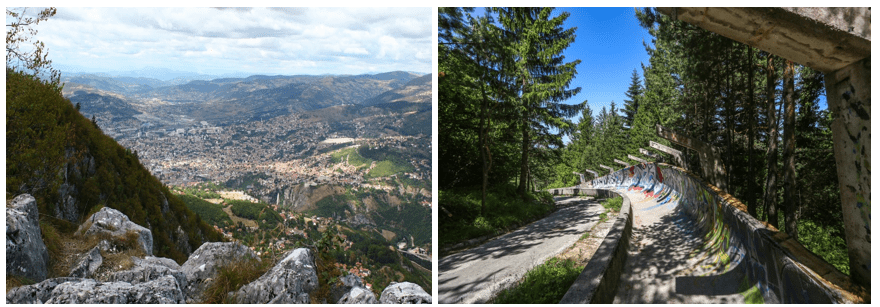STOP 1: Ex Hotel Holiday Inn & Sniper Alley (30 min)
The day’s first stop is ex Hotel Holiday Inn and a story about the famous Sarajevo Sniper Alley. Built for the Sarajevo 1984 Winter Olympics, today called Hotel Holiday, during the siege used to be home to various foreign journalists and reporters who were reporting on the Bosnian war and the siege of Sarajevo. A short walk along the infamous Sniper Alley and a few interesting stories related to this place are planned.
We pass by:
Markale Markets (largest massacre sites in Sarajevo during 1992-1995)
Eternal Flame (memorial dedicated to the victims of the WW2)
Children Memorial (memorial dedicated to 1601 children murdered in Sarajevo during 1992-1995)
Presidency (Bosnian Presidency house)
Parliament (Bosnian Parliament building)
Holiday Inn Hotel (built for the 1984 Olympics, used by journalists and reporters during the Siege)
STOP 2: Sarajevo War Tunnel Museum (1h 30 min)
The next stop of the day will be the War Tunnel Museum – Tunnel of Hope, which was the major “blood vessel” for the heavily sieged and destroyed city. At the tunnel, we shall see a short movie about the war in Sarajevo and the tunnel, followed by going through the tunnel itself.
At the exhibition part of the museum, we will have the opportunity to see many interesting exhibits directly connected with the siege of Sarajevo.
The trip to the tunnel and in the tunnel is covered with a true first-person experience of a classy guide, a survivor of the siege of Sarajevo, who is always willing to answer the question (no matter what they are). We will learn about the origins of the war in the Balkans and the death of Yugoslavia, the dreams Serbian leaders have had, and how they succeeded to seduce a large number of Serbian nationalists throughout the whole Balkans and making them go to war.
We pass by:
National Museum of Bosnia and Herzegovina (among many other wonderful exhibits, home to the famous Haggadah)
US Embassy
Ex-Marshall Tito Military Barracks (home to JNA troops at the beginning of the siege)
Neighbourhoods of Pofalici, Grbavica, Nedzarici, Alipasino Polje, Stup, Ilidza and Butmir
STOP 3: Trebevic Olympic Mountain (30 min)
After the tunnel, we head toward the mountain Trebevic which, by the vast majority of its length, was a first-line during the siege and the place of many battles on many battlefields.
At the site, we have the opportunity to see where the real destruction appeared, such as Zlatiste, Osmice, Trebevic Vidikovac, and many other destroyed facilities and sites.
Moreover, we will see the remains of bunkers, minefields, military tank caterpillar traces, tranches, bullets and grenade shrapnel, and many many other interesting sites of destruction, which today, at present, haven’t yet been repaired or restored. They just stand there like two decades later, the war hasn’t even ended yet.
STOP 4: Olympic Bobsled (30 min)
Sarajevo Bobsleigh, originally built for the 1984 Sarajevo Winter Olympics, is one of the main highlights of the tour. Once there, we can admire the Yugoslavian brutalist architecture, and learn more about the unfortunate events which took place at this location during the siege of Sarajevo, since it used to stand on one of the main front lines. However, bobsled is today featured at the top of the world’s most beautiful abandoned places lists. It holds an amazing amount of various graffiti by artists from all around the world, and you have a chance to see them all.
We pass by:
East Sarajevo & Lukavica (today Serbian majority part of Sarajevo)
Zlatiste and Osmice (infamous Serbian army sniper positions overlooking central Sarajevo)
Trebevic viewpoint (cable car final station and Serbian Army-controlled positions during the siege)
The tour is very much enriched with great panorama views, especially from the very top of Trebevic mountain. There you will get the real feeling of what the great mice and cats game had been played, and how the Republic of Srpska forces (VRS) with such a great advantage never got the real chance to take over Sarajevo city.

STOP 5: Jewish Cemetery (30 min)
Upon return to the city, the last stop of the day will be the Jewish cemetery, known for its historical importance as it is one of the largest Jewish cemeteries in Europe. However, during the siege of Sarajevo, it was the main front line and sniper nest of the Republic of the Srpska Army, overlooking the infamous Sniper Alley.
We pass by:
Vraca neighborhood (the first neighborhood that was controlled by the Army of the Republic of Srpska (VRS)
Sniper Alley (we will understand where VRS snipers used to fire from)
Grbavica Neighbourhood (VRS controlled part of Sarajevo during 1992-1995)
STOP 6: Yellow Bastion (30 min)
The last stop is made on the Yellow bastion – built in the early 18th century, the fort above the old town of Sarajevo and the Bosnian Army military cemetery of Kovaci was made for purpose of defense of the city during the Ottoman era. Today serves as a great viewpoint above Sarajevo and offers insight into a better understanding of the siege of Sarajevo.
Tour ends in the old town of Sarajevo.
We pass by:
Kovaci Army cemetery (Bosnian soldier’s cemetery from 1992-1995)
Vijecnica – Sarajevo City Hall (built during the Austria-Hungarian era, destroyed in 1992, reconstructed in 2014)
Latin Bridge – Princip’s Bridge (assassination point of Franz Ferdinand)





